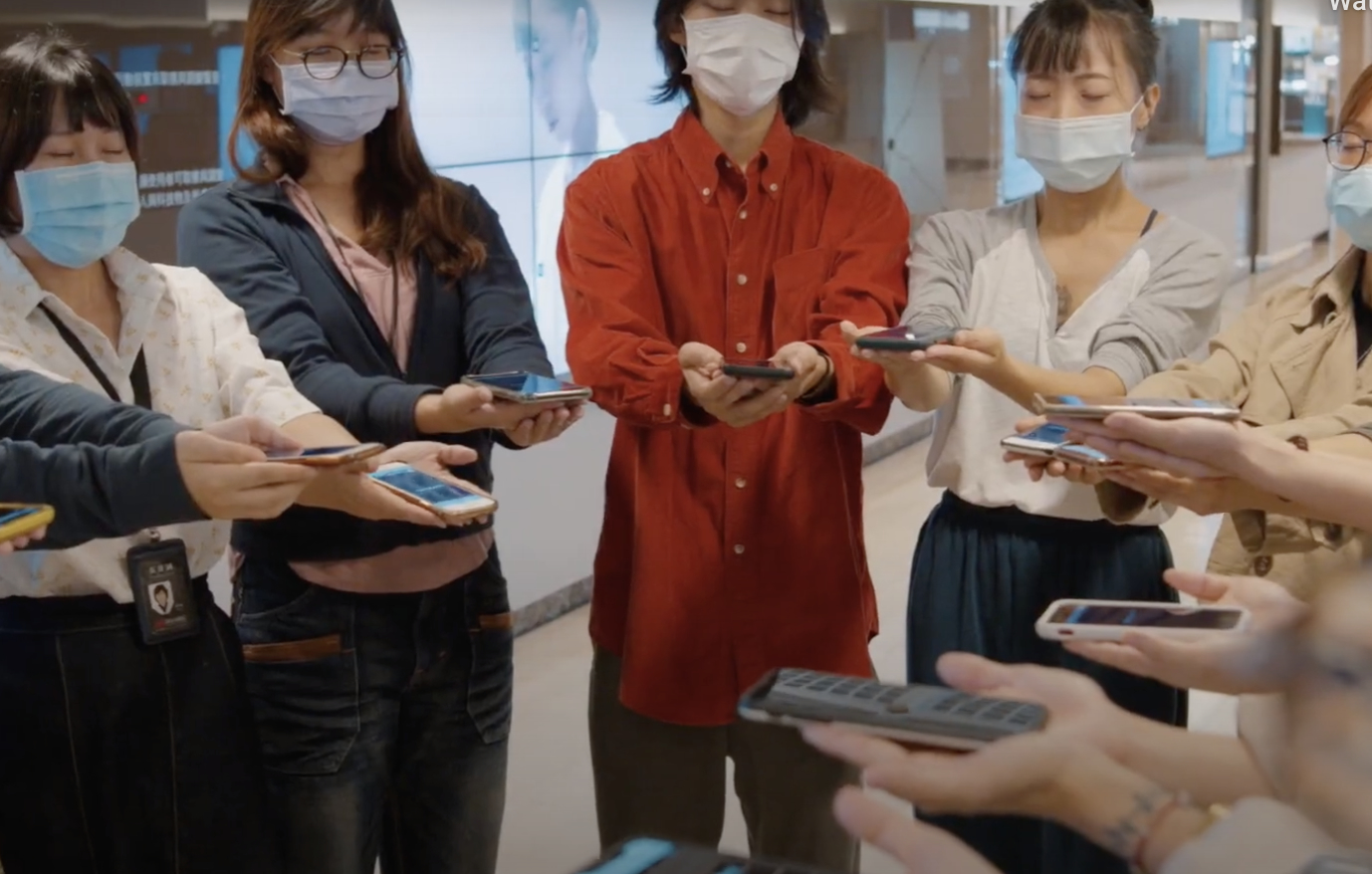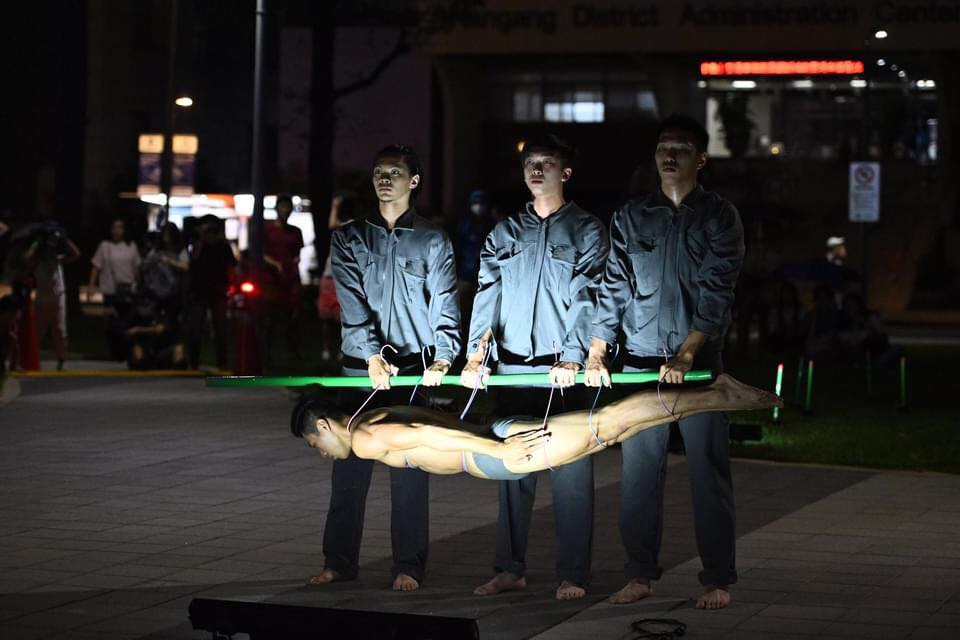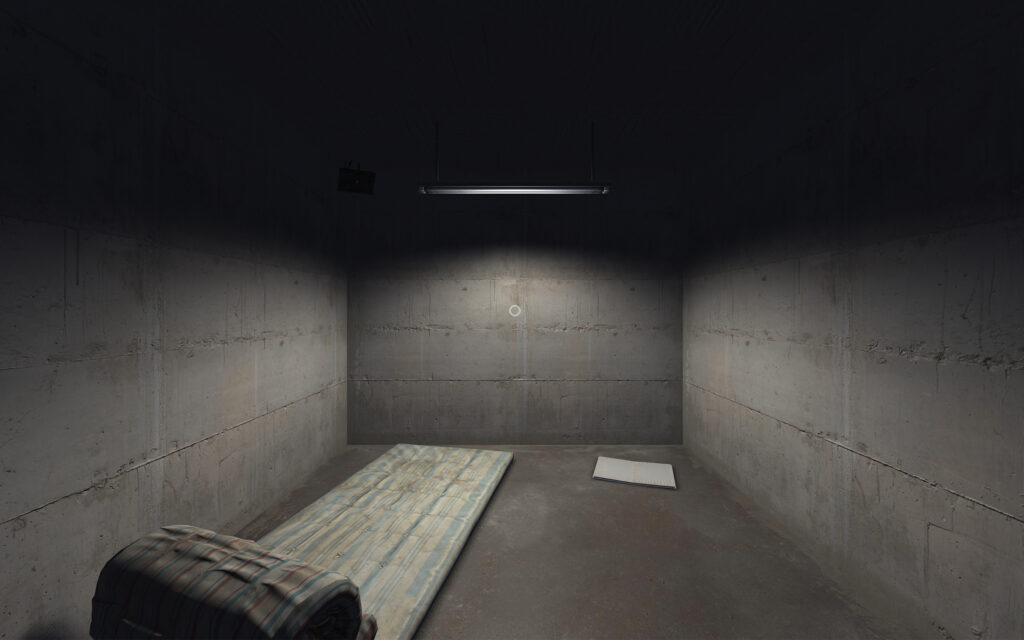Life & Art
In spite of pandemic obstacles, artists forge new paths
With the creative industries hard-hit, Taiwan’s artists are rethinking their practice and reimagining their futures
By Joanna Lee
 Chi Po-Hao and Zone Sound Creative’s Hertzian Playground allows audiences to interact with the art through smartphones. Screenshot from the Hertzian Playground trailer.
Chi Po-Hao and Zone Sound Creative’s Hertzian Playground allows audiences to interact with the art through smartphones. Screenshot from the Hertzian Playground trailer.
From the all-night art marathon of Nuit Blanche (白晝之夜) to the star-studded red carpets of Taipei Fashion Week (臺北時裝週), with the former drawing in an estimated 400,000 revellers, it’s easy to sidestep the fact that this year’s festival calendar was anything but business as usual.
The pandemic bubble and relaxed social distancing measures of Taiwan have meant that arts and culture events, and in turn the creative industries, have been quicker to recover than elsewhere in the world. However, for an industry that is predicated on both the ‘live’ experience and international exchanges, the aftershocks from the March-July period are still being felt. For some, the losses were tremendous – and enough to start thinking about switching gears.
Organisations and groups in the performing arts sector, like Taiwan’s renowned contemporary circus troupe Formosa Circus Arts (FOCA), were some of the most affected; as its devoted founder Allen Lin (林智偉) tells me, FOCA lost NT$8 million due to cancelled performances. Moreover, of the 12 overseas trips originally scheduled, only four in the beginning of the year were realised.
It’s a grim contrast to what was supposed to be a bang of a year – ten years since its founding – with the scope of its operations having already been expanded in anticipation of the anniversary. Lin still grimaces when he looks back at the March-July period when FOCA was most financially strained; an organisation that currently employs almost 20 full-time workers and spends about NT$1 million in monthly expenses, they were hemorrhaging money every month, on top of the NT$8 million in cancellations. “The figures were really shocking,” Lin says, sighing. “It can really put one at a loss for what to do.”
 Formosa Circus Arts’ recent performance as part of the 2020 Nuit Blanche Taipei.
Formosa Circus Arts’ recent performance as part of the 2020 Nuit Blanche Taipei.
Image courtesy of FOCA, photographed by 林軒朗.
It’s under such conditions, echoed throughout the creative industries, that the Ministry of Culture rolled out its NT$5.22 billion Covid relief budget, busily fast-tracking thousands of applications to ensure there was no ‘blackout’ in the arts, as then Minister of the Council for Cultural Affairs Cheng Li-chun (鄭麗君) stated back in April. Though governments around the world are trying to patch up their respective creative industries, mass layoffs and closures have writers and analysts deeming the situation a crisis, particularly in countries like the UK. As The Conversation noted last week, the pandemic has brought to the surface “the precarity of the creative labour market”, and just how easy it can be for creative workers to fall through the gaps.
Keenly aware that relief packages might only serve to stop the bleeding, the Ministry of Culture has also taken up different measures to revitalise the sector, launching a NT$10 billion loan scheme under the Taiwan Creative Content Agency (TAICCA) in September, and grants specifically for ‘Covid projects’ – works that encourage individuals and organisations to develop new strategies to overcome the physical barriers of a pandemic at large, such as the ‘Beyond Covid-19’ grant under the National Culture and Arts Foundation (NCAF).
Such funding has given artists and creative workers not only the opportunity to continue their practice, but also find innovative and more digital ways to make their mark.
New generation poet Lin Yu-Hsuan (林宇軒), for example, has been able to merge the old with the new, using podcasting as a way to take literature online. Though, as he says, podcasts are “all the rage in Taiwan this year”, his project is one of the first-ever to receive government support. At the very least, it’s pushing the boundaries and traditional ideas of what could – or couldn’t be – funded.
Though literary works are not necessarily tied to the live experience, a flurry of physical activities accompany them, such as talks, awards and literary festivals – all of which have been affected in this pandemic timeline. Seeing events like this year’s Taipei International Book Exhibition (TIBE) having to either scale down or move entirely online, Lin was motivated to think of new ways for audiences to engage with literature. “People usually think of literature as something much more visual,” he says. “But I want audiences to see that literature can also be manifested in different ways, such as sound.”
 Artist Chi Po-Hao’s VR project Virtual Confinement experiments with new modes of experience
Artist Chi Po-Hao’s VR project Virtual Confinement experiments with new modes of experience
Courtesy of Chi Po-Hao.
Similarly, Chi Po-Hao (紀柏豪), an interdisciplinary artist who explores the intersections of art and technology, is trying to work more with virtual formats like WebVR. Through the ‘Beyond Covid’ grant, Chi has been able to work on interactive, web-based experiments like ‘Virtual Confinement’ or ‘A Fictional Landscape of Togetherness’, whereby Chi and his collaborators attempt to model their experiences into a fictional, virtual landscape.
Currently completing his MS in Art, Culture and Technology at the Massachusetts Institute of Technology, Chi says the pandemic has not only made it challenging for him to produce physical objects, but also maintain his connections with different arts communities. For someone who usually participates in numerous local and overseas exhibitions and festivals, this year is a much quieter one for him: “Taiwan’s art scene has become even more prosperous than usual – there are many activities in the second half of the year,” he says. “[But] I was not that connected to those activities since I am now in Boston.”
“There are many virtual exhibitions, workshops and lectures, but I felt that I still wanted to have in-person interactions, even for participating exhibitions or presenting projects.”
One of his more recent works, Hertzian Playground, was part of the National Theater and Concert Hall’s (NTCH) Next Theater, a micro-programme that sought to showcase the post-pandemic potential of art outside the theater. Though there had been a physical component at NTCH, Hertzian Playground prompted users to interact with their smartphones, engaging with music and sound as they performed gestures with their devices.
However, Chi is uncertain about the project’s future: “It’s more like a prototype than a complete performance now. I might continue working on it, but it depends on the funding.”
While most practitioners recognise funding and institutional support as necessary, many are also wary about overstating the importance of this lifeline. Though Chi is grateful for the support he has received, he thinks it can often lead to negative outcomes in the industry: “Subsidies cause rent-seeking behavior, which is harmful to efficiency,” he says.
For others, like FOCA’s Allen Lin, it is also something that begs further consideration, especially in the context of sustaining an organisation in the long run. Speaking about the creative industries’ rush to move works online, Lin says it is important to see past the initial excitement and consider the possibility of it becoming something that is only done for the sake of funding.

Part of Formosa Circus Arts’ post-pandemic planning involves branching out into publications Image courtesy of FOCA
Having been at the frontlines since FOCA’s inception and seen projects start and finish, members come and go, one of Lin’s instincts has always been to fight for members’ salaries. As someone who had a major hand in elevating circus arts from stunt work and petty backup performances in the entertainment industry to a contemporary art practice in Taiwan, Lin has always looked to the future. He says that growing up, National Fu Hsing Dramatic Arts Academy (now the National Taiwan College of Performing Arts) graduates like him were often faced with the sad reality of retiring at 28, after more than ten years of gruelling training and another handful picking up backbreaking gigs in the entertainment industry; the desire to change this fate was exactly what led him to starting FOCA in the first place.
Now, the pandemic has only made him more acutely aware of the importance of future planning and diversification. “If we have a pandemic or health crisis every two or three years in the future, we need to have a contingency plan,” he says. “These five months have given us a breather, and we’ve used the time to consult with mentors, consultants and even insurance companies on how to better plan members’ futures.”
Aside from upskilling members, FOCA has also ventured into publishing, putting together a magazine that would allow them to disseminate more information about not only their organisation, but also about the field of circus arts. Though the practice has evolved dramatically over the last ten years, partly brought on by FOCA’s very presence, Lin says there is still a gap between it and the more traditional performing arts, such as theater.
He hopes that by acquainting the general public with the practice, through free resources like FOCA’s magazine, the entire ecosystem can be opened up. As he says, “It can’t just be that we’re doing well – this is for everyone in the field.”
Joanna Lee is a Taiwanese-Australian freelance writer, editor and translator based in Taipei